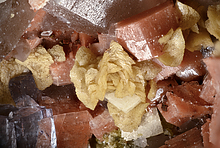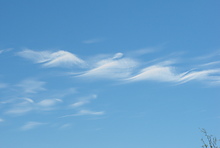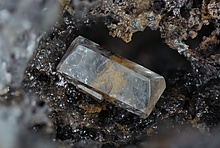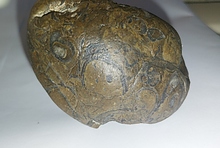Learning CenterWhat is a mineral?The most common minerals on earthInformation for EducatorsMindat ArticlesThe ElementsThe Rock H. Currier Digital LibraryGeologic Time
搜索矿物的性质搜索矿物的化学Advanced Locality Search随意显示任何一 种矿物Random Locality使用minID搜索邻近产地Search Articles搜索词汇表更多搜索选项
╳Discussions
💬 Home🔎 Search📅 LatestGroups
EducationOpen discussion area.Fakes & FraudsOpen discussion area.Field CollectingOpen discussion area.FossilsOpen discussion area.Gems and GemologyOpen discussion area.GeneralOpen discussion area.How to ContributeOpen discussion area.Identity HelpOpen discussion area.Improving Mindat.orgOpen discussion area.LocalitiesOpen discussion area.Lost and Stolen SpecimensOpen discussion area.MarketplaceOpen discussion area.MeteoritesOpen discussion area.Mindat ProductsOpen discussion area.Mineral ExchangesOpen discussion area.Mineral PhotographyOpen discussion area.Mineral ShowsOpen discussion area.Mineralogical ClassificationOpen discussion area.Mineralogy CourseOpen discussion area.MineralsOpen discussion area.Minerals and MuseumsOpen discussion area.PhotosOpen discussion area.Techniques for CollectorsOpen discussion area.The Rock H. Currier Digital LibraryOpen discussion area.UV MineralsOpen discussion area.Recent Images in Discussions
Identity HelpGeology in general

10th May 2012 21:37 UTCAnonymous User
11th May 2012 02:39 UTCRalph S Bottrill 🌟 Manager

11th May 2012 03:29 UTCKelly Nash 🌟 Expert
- Kelly Nash (Geologist)

11th May 2012 07:14 UTCTom Goodland
I mostly like collecting minerals but often come across attractive and intriguing rocks. Does anyone know of a website which describes, with good colour photos, all the myriad different types of rocks found around the world. Info on each, such as constituent minerals, type of geological formation & distribution would be very useful. A search for such websites came up with sites with only a few common rocks aimed at children.
I also like collecting fossils (i have very catholic tastes!). Is there anything similar to Mindat but for fossils (Fosdat)? I know palaeontology is a vast subject with probably even more contentious issues around collecting (exactly where a fossil comes from being all-important for scientific value).
thanks
tom goodland

11th May 2012 11:07 UTCBecky Coulson 🌟 Expert
Like you, I enjoy collecting rock samples in addition to minerals - and they are often more difficult to identify because of their varying composition! I have yet to find a decent website along the lines of Mindat, with specimen photos from specific localities uploaded. Although some universities, museums, etc. have uploaded their own collections and slides, I don't know of a petrology website - I hope someone can help us with this! I have a real interest in volcanics, and have had to rely heavily on field guides and local experts to help me. I keep dreaming of finding a book along the lines of "Volcanoes and their products", with samples from individual sites. Becky

11th May 2012 12:59 UTCD Mike Reinke
I know of no site like you've looked for, only very scattered info in books. Simon & Schuster's guide to rocks is well illustrated, I think.
A general site you might like is Raymond Wiggers' site. He gives outstanding slide shows, just caught one at the local library, and his book, and picture captions are a good read. Not an analysis of rock types, but an appreciation of them.
11th May 2012 13:40 UTCNorman King 🌟 Expert
After working with the Cretaceous pelecypod family Inceramidae, it took about ten years before anyone came to me for ID's. Even then, if I said that Mytiloides lusatiae (for example) occurs in the basal Fort Hays Limestone in Colorado and New Mexico, many people would ask me by whose authority I could say that. Turns out it doesn't occur there, but American workers, including myself, thought so until recently Ireneusz Walaszczyk of Poland, working with Bill Cobban of the US Geological Survey, determined that species had been Mytiloides scupini all along.
Such is the ridiculous "game" that goes on in paleontology, and that is the reason, when I had the option way back in the 1970's of specializing in either paleontology or physcial stratigraphy (including many aspects of sedimentology), I chose the latter. Nevertheless, it is probably still true (as it was in the 60's, 70's, and 80's) that stratigraphic paleontologists make more money in the petroleum industry that almost any other specialty. That is because so few people could do it. But I could! (And, paradoxically, it would never had made any difference what we called that stupid species of Mytiloides).
11th May 2012 14:37 UTCRalph S Bottrill 🌟 Manager
The problem with rocks is that to categorise them properly you really need a thin section, polarizing microscope and often a full chemical analysis, else you are just guessing. Guessing based on macroscopic appearance may be good enough if you are happy to call something a broad name like basalt, granite or sandstone, but you still need a good hand lens and a few physical tests. Most basic geology and mineralogy books & websites give the basics of rock classifications, some illustrated, but a macrophoto of a basalt may not look much different to some sandstones, mudstones, quartzites, limestones, hornfels etc.
There is a place still for a Rockdat type database still, IMO, with photos and thin sections of rocks from various places; I dont know of anything existing that approaches this.The trouble is we need to get a few more geologist on board, most of us have too much to do with mindat still!

11th May 2012 14:58 UTCKelly Nash 🌟 Expert
For both fossils and rocks, if you're trying to identify things in a particular area, you may be better off finding a good field guide to the geology of the area (or a human guide) rather than a rock or fossil book. That also helps a lot with minerals, but at least with minerals, once you have seen enough of them, you begin to recognize a good number of them (especially if they are crystals) no matter where you are, though you may sometimes have to supplement your visual ID with testing.

11th May 2012 15:42 UTCAlex Homenuke 🌟 Expert
I have no idea what came over me to write this (Al, a geologist)
11th May 2012 20:53 UTCPaul Brandes 🌟 Manager
Heath; please ask your geology questions here. As Kelly mentioned it will be a very refreshing change of pace.

11th May 2012 21:44 UTCAnonymous User
Also the gravel bed contains a lot of magnetic material mostly basaltic andesite, that i believe origionated from the nearby Cleveland dyke the dyke formed 58 mya and ive found the stone attracts a weak magnet quite easilly, ive tested 4 different outcrops but the dyke at my home area is by far the most magnetic.
11th May 2012 23:17 UTCNorman King 🌟 Expert
Do you have any photos of the gravel bed and the alluvial material above it? That would sure help me in understanding what you have found.
11th May 2012 23:42 UTCMartin Rich Expert
try this (english is available):
http://www.efbz.de/
http://www.natursteinonline.de/steinsuche/steinsuche.html
Martin

12th May 2012 00:17 UTCAnonymous User

12th May 2012 00:19 UTCAnonymous User
-------------------------------------------------------
> Heath,
> try this (english is available):
>
> http://www.efbz.de/
>
> http://www.natursteinonline.de/steinsuche/steinsuc
> he.html
>
>
> Martin thanks i will try them.

12th May 2012 07:07 UTCTom Goodland
thanks for the link (a database of 4500 rocks from round the world). I'm not sure of its usefulness when trying to identify rocks but it's interesting, as my "day job" is a builder!
tom
12th May 2012 11:09 UTCRalph S Bottrill 🌟 Manager

12th May 2012 11:38 UTCErik Vercammen Expert




版权所有© mindat.org1993年至2024年,除了规定的地方。 Mindat.org全赖于全球数千个以上成员和支持者们的参与。
隐私政策 - 条款和条款细则 - 联络我们 - Report a bug/vulnerability Current server date and time: 2024.4.19 07:43:14
隐私政策 - 条款和条款细则 - 联络我们 - Report a bug/vulnerability Current server date and time: 2024.4.19 07:43:14











